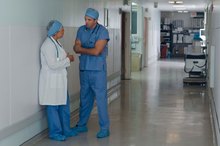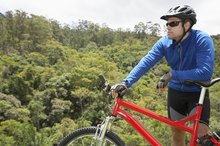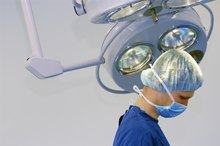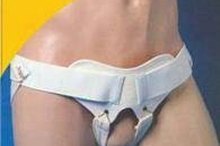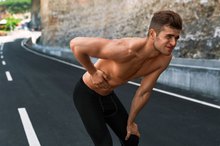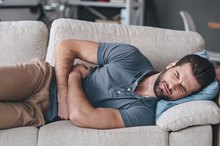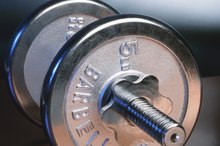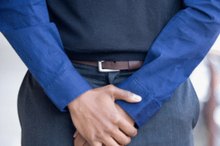What does fact checked mean?
At Healthfully, we strive to deliver objective content that is accurate and up-to-date. Our team periodically reviews articles in order to ensure content quality. The sources cited below consist of evidence from peer-reviewed journals, prominent medical organizations, academic associations, and government data.
- Journal of the American College of Surgeons: What Effect Does the Duration of an Inguinal Hernia Have on Patient Symptoms?
- Journal of the American College of Surgeons: What Effect Does the Duration of an Inguinal Hernia Have on Patient Symptoms?
The information contained on this site is for informational purposes only, and should not be used as a substitute for the advice of a professional health care provider. Please check with the appropriate physician regarding health questions and concerns. Although we strive to deliver accurate and up-to-date information, no guarantee to that effect is made.
Hernia Signs and Symptoms in a Male
Your internal organs and tissues are separated into compartments. Weakness in a separating "wall" can lead to a hernia -- a condition wherein internal tissues bulge into an area where they are not normally found. There are many types of hernias, but the overwhelming majority in men occur in the groin. The signs and symptoms of a hernia in a male vary depending on the site, size and severity of the hernia. Symptoms often develop gradually but may occur suddenly after heavy lifting or straining.
If you are experiencing serious medical symptoms, seek emergency treatment immediately.
Groin Lumps
Most hernias occur in the groin, and men have a much higher lifetime risk of developing a groin hernia compared to women. The most common sign is a soft lump in the groin, which may initially be noticeable only when coughing or straining. Groin hernias tend to be small at first -- often smaller than the tip of the thumb -- but increase in size over time to golf-ball size or larger. Hernia lumps in men usually develop over the pubic bone just to the side of the genitals. The scrotum on the affected side may also be larger. Less commonly, a groin hernia causes a lump lower in the groin, at the crease where the leg and hip meet. Hernia lumps often disappear when lying down.
- Most hernias occur in the groin, and men have a much higher lifetime risk of developing a groin hernia compared to women.
- Groin hernias tend to be small at first -- often smaller than the tip of the thumb -- but increase in size over time to golf-ball size or larger.
Discomfort and Pain
Symptoms of Groin Hernia in Male
Learn More
Discomfort or pain is the leading symptom of a groin hernia, occurring in approximately two-thirds of men, according to an August 2001 study published in the "Journal of the American College of Surgeons." The pain is often described as dull, mild or achy. It may be brought on by strenuous physical work or prolonged standing. It is typically felt in the lower abdomen or groin, and may extend into the scrotum or inner thigh. Some men report feeling pressure or heaviness rather than frank pain. A hernia that develops suddenly may cause sharp pain. Lying down or holding pressure on a hernia lump often alleviates the discomfort or pain.
- Discomfort or pain is the leading symptom of a groin hernia, occurring in approximately two-thirds of men, according to an August 2001 study published in the "Journal of the American College of Surgeons."
- It may be brought on by strenuous physical work or prolonged standing.
Other Symptoms
Although groin hernias predominate in men, other external and internal hernias can occur. External, abdominal wall hernias can develop around or above the navel or at the site of surgery scars, with a lump and local pain or discomfort similar to a groin hernia 4. Symptoms of these hernias also often go away when lying down. Both men and women can have an internal hiatus hernia, wherein the tube that carries food to the stomach bulges into the chest cavity. A hiatus hernia often causes frequent heartburn.
- Symptoms of these hernias also often go away when lying down.
When to See a Doctor
Inguinal Hernia Symptoms in Women
Learn More
If you suspect you have a hernia -- whether symptoms have been present for a while or have come on suddenly -- make an appointment with your doctor for diagnosis and treatment recommendations. Uncommonly, a portion of the bowel becomes trapped in a hernia opening, cutting off the blood supply to the affected segment of the bowel. This condition, known as a strangulated hernia, is a medical emergency and requires immediate treatment. Signs and symptoms include a sudden increase in the size of the hernia lump, severe pain and tenderness at the site of the hernia, nausea, vomiting and fever.
- If you suspect you have a hernia -- whether symptoms have been present for a while or have come on suddenly -- make an appointment with your doctor for diagnosis and treatment recommendations.
Related Articles
References
- American Family Physician: Inguinal Hernias: Diagnosis and Management
- JAMA Surgery: Management of Asymptomatic Inguinal Hernia: A Systematic Review of the Evidence
- Abdominal Wall Hernias: Principles and Management; Robert Bendavid, Ed.
- The Merck Manual Professional Edition: Hernias of the Abdominal Wall
- Essentials of General Surgery, 5th Edition; Peter F. Lawrence, et al.
- Journal of the American College of Surgeons: What Effect Does the Duration of an Inguinal Hernia Have on Patient Symptoms?
- The Merck Manual Professional Edition: Hiatus Hernia
- Fitzgibbons RJ, Forse RA. Groin hernias in adults. N Engl J Med. 2015;372(8):756-763. doi:10.1056/NEJMcp1404068
- Merriam-Webster Dictionary. Definition of HARUSPEX. Updated 2020.
- Mahadevan V. Essential Anatomy of the Abdominal Wall. In: Kingsnorth A, LeBlanc K, eds. Management of Abdominal Hernias. Fourth. London: Springer Science & Business Media; 2013:25-55.
- M BS. SRB’s Manual of Surgery. Sixth. London: Jaypee Brothers, Medical Publishers Pvt. Limited; 2019:739-776.
- Wang H, Naghavi M, Allen C, Barber R, Bhutta ZA, Carter A. Global, regional, and national life expectancy, all-cause mortality, and cause-specific mortality for 249 causes of death, 1980–2015: a systematic analysis for the Global Burden of Disease Study 2015. The Lancet. 2016;388(10053):1459-1544. doi:10.1016/S0140-6736(16)31012-1
- Hoffmann H, Walther D, Bittner R, Köckerling F, Adolf D, Kirchhoff P. Smaller inguinal hernias are independent risk factors for developing chronic postoperative inguinal pain (CPIP). Annals of Surgery. 2020;271(4):756-764. doi:10.1097/SLA.0000000000003065
- Dhua AK, Aggarwal SK, Mathur N, Sethi G. Bilateral congenital diaphragmatic hernia. APSP J Case Rep. 2012;3(3):20. PMID: 23061036
Writer Bio
Kari Oakes is a Maryland-based health and medical writer and a certified physician assistant. Her clinical experience in primary care and emergency medicine gives her real-world insight into a host of medical conditions and health concerns. Her work has appeared in HCPLive/Cardiology Review, DocGuide, FirstWord Pharma and Frontline Medical News.
